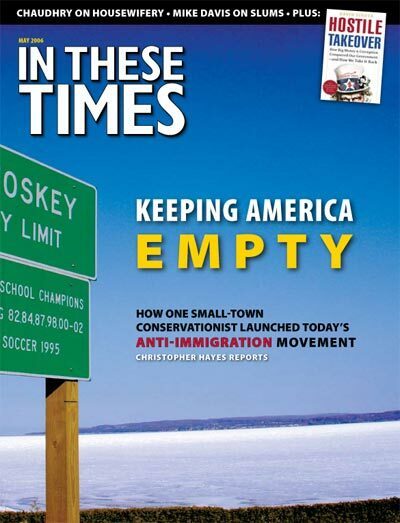Within the last few years, Slavoj Zizek has gained a name for himself as a political commentator. After his essay on 9/11, “Welcome to the Desert of the Real,” he steadily increased his popular writing, publishing in seemingly every possible venue (including In These Times) in response to virtually every major news story. Meanwhile, Zizek was said to be hard at work on another long book, The Parallax View, which he was already claiming as his magnum opus months before its recent release.
Frankly, a magnum opus is exactly what Zizek needs right now. His performance as a public intellectual has met with decidedly mixed reviews, with much of his new audience wondering if they should take his counterintuitive and often outrageously provocative assertions seriously. At the same time, many of his long-time readers have grown impatient with Zizek’s failure to produce more work of the caliber that made his academic reputation in the 1990s.
Zizek is known for his frequent use of film and pop culture, his huge range of philosophical and literary references, and his obscene jokes – all packaged in overarching metaphors involving something like a rollercoaster (or in one particularly bizarre case, a mulcher). The Parallax View includes all of these things: extended riffs on the Matrix trilogy, a section on Henry James’ prose style, a Hegelian approach to sexual positions, a highly questionable analysis of anti-Semitism and a wide array of other digressions, often brilliant, sometimes plodding, with varying degrees of relevance to the topic at hand. More significantly, however, The Parallax View consolidates Zizek’s work as a whole and decisively moves it forward.
Zizek uses “parallax” to refer to situations in which the “same thing,” when viewed from two different perspectives, presents itself to the observer in two completely irreconcilable ways. A good example of this is light, which can be viewed as both a wave and a particle, with no way of mediating between the two positions. Rather than a conflict of two opposing principles, parallax names “the inherent ‘tension,’ gap, noncoincidence” of reality with itself.
His ambition here is to develop a new dialectical materialism. The philosophical idea of materialism is simple enough: no God, no souls, etc. Matter is all there is. What a specifically dialectical materialism adds is the idea of the conflictual and inconsistent character of matter itself, in contrast to the idea of the universe as a machine running smoothly in accordance with transparent physical laws. Zizek uses this fundamental insight into the conflictual character of existence to investigate three kinds of parallax – philosophical, scientific and political. (This division allows for, in Zizek’s words, “a minimum of conceptual order.”)
The philosophy section is the most loosely organized. One chapter expands on his recent work on Christianity. For Zizek, part of Christianity’s “subversive core” is the idea of Christian love: “the excessive care for the beloved, a ‘biased’ commitment which disturbs the balance” of normal reality. The space for this love is opened up by the believer’s act of “unplugging” from all social ties in order to be completely faithful to Christ. For Zizek, St. Paul’s relativization of all social roles, indicating that the believer does not “belong” to the present order, is a subversive action of refusal. It explains Zizek’s interest in Christianity in the first place: This refusal to identify with the present order is a vital precursor to any attempt at revolutionary change.
The science section is the most important: No one is going to be impressed by a materialism, dialectical or not, that cannot make sense of science. Embracing cognitive and brain science – a subject many psychoanalysts have viewed with suspicion – Zizek rejects the idea that science can somehow “go too far” and destroy something essential to humanity, in this case, the idea of consciousness and free will. Rather than fretting that discovering the brain processes that underlie consciousness will somehow undermine our experience of consciousness, Zizek wants to determine what happens at the level of neuronal processes to give rise to the dimension of consciousness, and of human free agency.
To determine this, Zizek surveys a range of cognitive scientists, pointing out inconsistencies in their accounts of how consciousness arose. Acknowledging the field’s diversity, he lays out several basic positions, ranging from the idea that consciousness simply doesn’t exist to the idea that consciousness cannot be explained by other forces and must be taken as an independent force analogous to gravity or magnetism. But he rejects these ideas in favor of a more materialist position. Zizek agrees with those who think consciousness emerges out of a kind of short-circuit in the neuronal circuitry. Essentially, according to cognitive scientists such as Antonio Damasio, the “mental map” of the human being’s surroundings increased in complexity until it finally reached the point where there was a representation of the “self” in the map. Thus, the mind was able to think about itself, and for Zizek this reflexive move produced the unintended consequence of consciousness.
Within this scheme, conscious free choice does not directly “cause” human action in a straightforward way. Instead, free choice is first of all a negative move of refusal, because only the refusal to continue along in the chain of instinctual reactions opens up space for other possibilities. Far from being the pinnacle of evolution, then, humanity becomes the ultimate anti-adaptive species, with consciousness opening the way for the expenditure of huge amounts of energy on pursuits – such as language, art, and above all, non-procreative sex – that have nothing to do with “survival of the fittest.” Thus, Zizek is proposing a model of human freedom that avoids both pure mechanical determinism and the illusion of pure Promethean self-creation, where humanity creates itself by continually turning the given reality toward surprising new ends. As with his analysis of Christianity, this vision also has a political punch: We are most human when we refuse to act according to a supposed historical necessity or biological laws.
The final section on politics is probably of greatest interest to a general audience that came to Zizek through his popular articles and hope to learn of the positive program that underlies his criticism of various politicial movements. However, a large chunk of this section is taken up with those very same articles, including pieces on why Stalinism is to be preferred over Nazism, on Thomas Frank’s What’s the Matter With Kansas?, etc. While these articles actually do make more sense when presented together, their inclusion contributes to an overall feeling of anti-climax. This feeling is only deepened when he advocates as a model revolutionary Herman Melville’s Bartleby, whose constant refrain, “I would prefer not to,” is the exact opposite of an inspiring political slogan.
Even here, however, Zizek is making a serious argument. As he has demonstrated throughout, negativity or refusal was at the core of both the Christian movement and the evolutionary emergence of human consciousness and culture. In both cases, what has been most valuable has stemmed from continued refusal, for example, the refusal to submit to the laws of nature by settling for the satisfaction of one’s animal needs. And so Zizek’s vision of revolution is one in which “an underlying ‘I would prefer not to’ … forever reverberates,” in which the refusal never lets up, even and especially in the building of a new positive order. If Zizek is correct that, “there is no final solution on the horizon today; Capital is here to stay; all we can hope for is a temporary truce,” then perhaps the true task of those who hope for revolution is to imagine what such a thorough-going refusal might mean.





